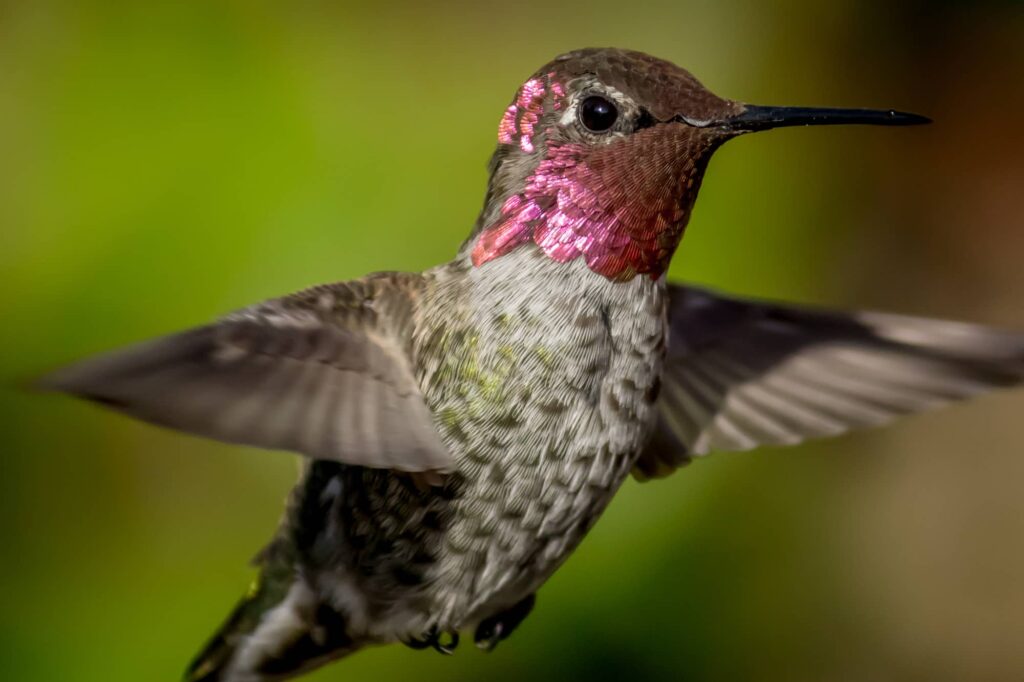Arkansas, a southern US state bordering the Mississippi River, is famous for its mountains, caves, rivers, hot springs, parks, and wilderness areas. So whether Arkansas is your home state or you’re passing through for a short family visit, or you’re going on a hiking trail with friends, keep an eye out for the beautiful birds found in Arkansas.
Nine exquisite wild hummingbird species are part of the official list of the Arkansas Audubon Society (AAS) 423 bird species, to the delight of bird enthusiasts. Some of these hummers are rare or occasionally pass through the state.
Below, we’ve compiled a list of hummingbirds in Arkansas to keep an eye out for, whether you are out hiking or lounging outside.
Ruby-Throated Hummingbird (Archilochus Colubris)
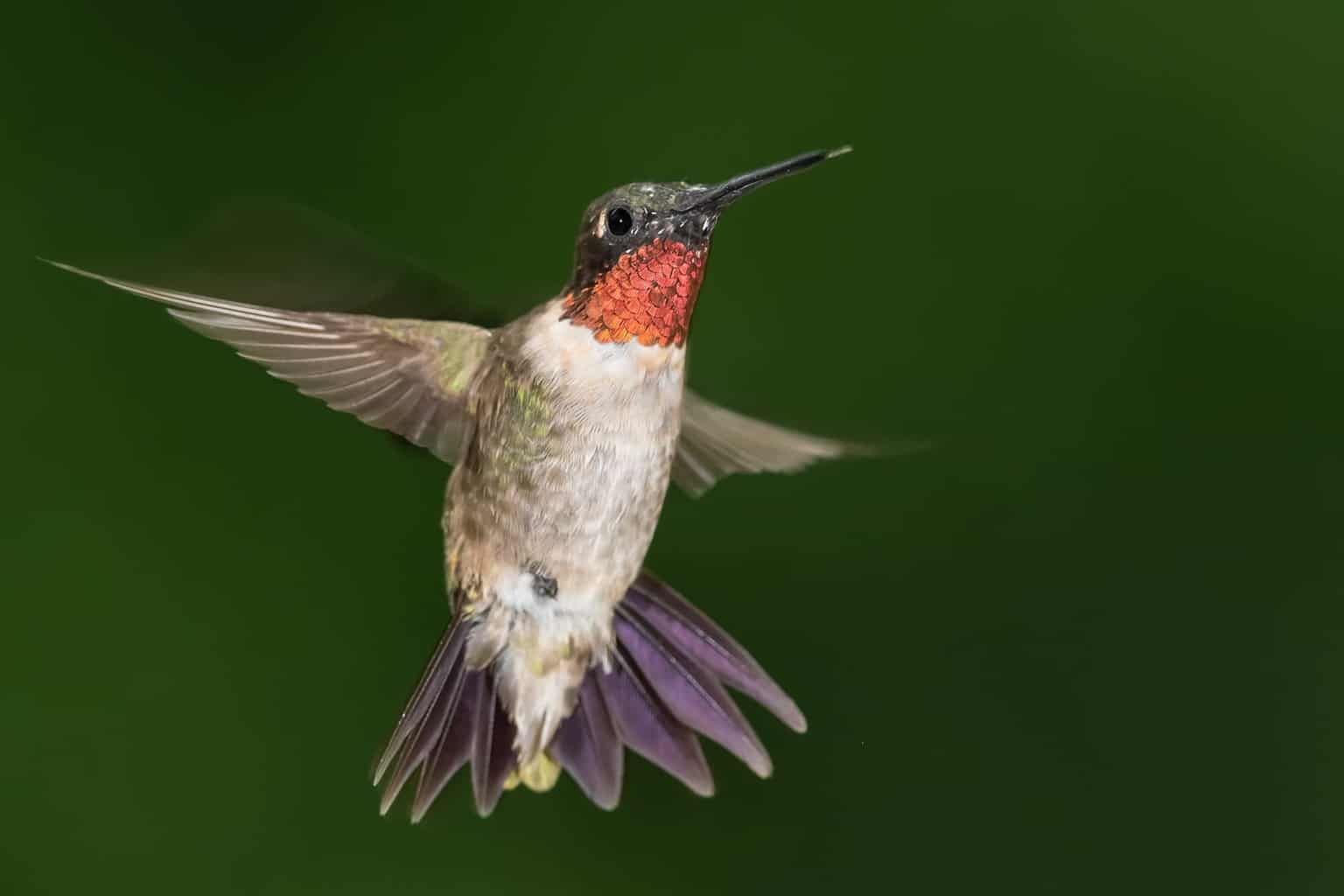
- Length: 2.8 to 3.5 inches
- Weight: 3.4 grams for males and 3.8 for females
- Wingspan: 4.1 to 4.3 inches
Description:
Male Ruby-throated hummingbirds have iridescent ruby-red gorgets, emerald-green backs, and forked tails. Ruby-throated hummingbird females, meanwhile, have dull green backs, white-banded, forked tails, and plain gorgets with faint dusky streaks.
Immature birds resemble adult females.
Additional Information:
Ruby-throated hummingbirds are the only hummers known to nest in Arkansas. They arrive in Arkansas from late March to early April and leave between September and October.
Ruby-throated hummingbirds enjoy feeding on natural nectars from brightly colored, scented native flowers of shrubs, trees, and epiphytes.
Red or orange tubular flowers with a high concentration of nectar will attract these beautiful birds to yards and traditional bird baths. You could also consider setting up a quality hummingbird feeder and making a homemade sugar-water mixture with a sugar to water ratio of one-quarter cup of sugar and one cup of water.
Mexican Violetear (Colibri Thelassinus)
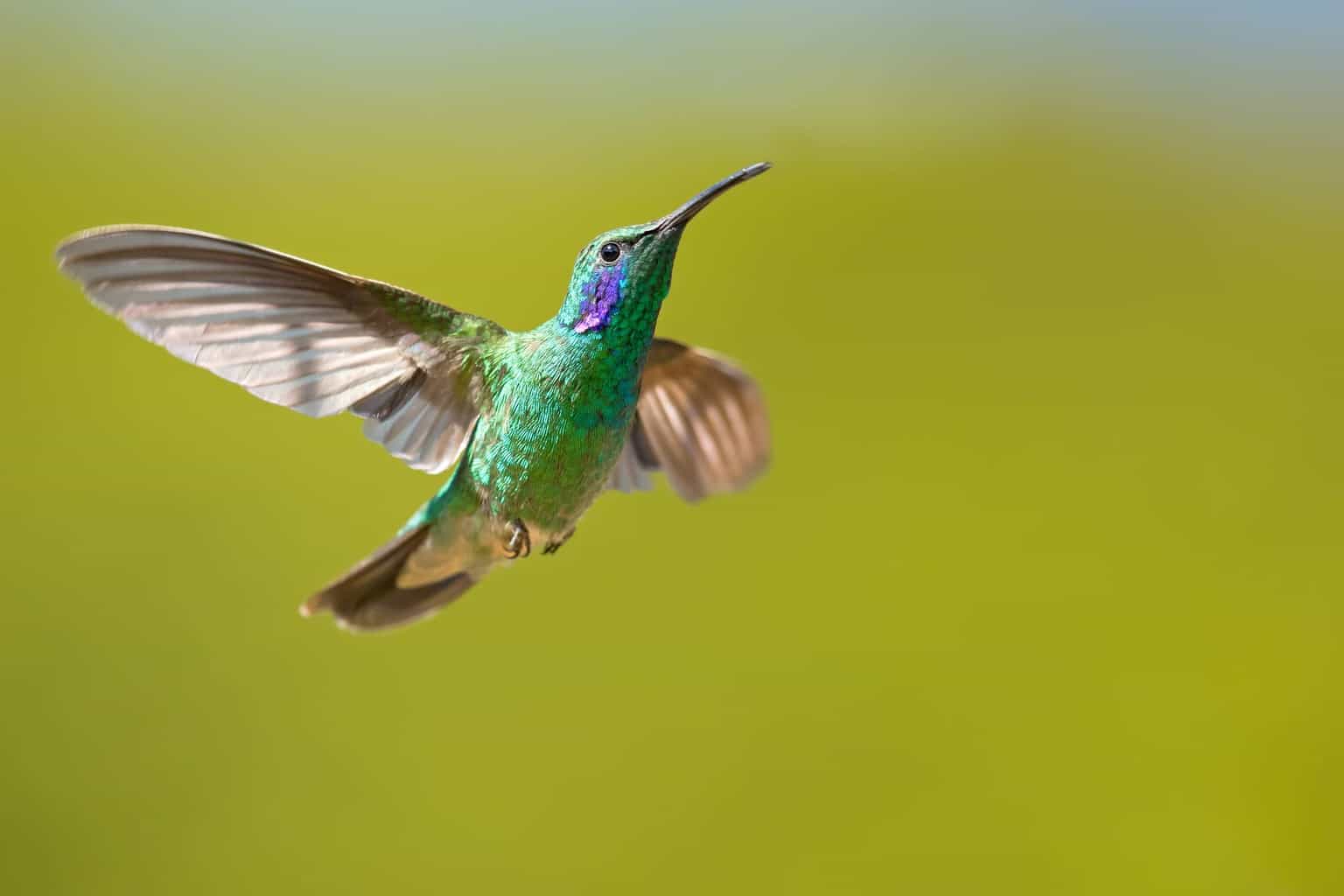
- Length: 3.8 to 4.7 inches
- Weight: 4.8 to 5.6 grams
- Wingspan: 4.7 inches
Description:
Also known as the Green Violetear, the Mexican Violetear is a colorful, medium-sized hummingbird.
Mexican Violetears have black bills almost one inch long and overall glossy, emerald green plumage with dark violet ear patches and breasts. Female Violetears have a similar but slightly duller appearance.
Additional Information:
Common hummingbirds to Central America, Mexican Violetears typically live and forage alone, feeding on native plants at mid-level canopies in shrubs or deforested areas. These dominant birds fly in a u-shape pattern to court females during the breeding season.
Mexican Violetears are vocal birds and sing a jerky, chipping melody from exposed twigs in their territorial areas. Additionally, their call sounds like a dry ‘chut.’
They sometimes gather at flowering trees, especially coffee-shade Inga. Mexican Violetears primarily feed on nectar from plants and small insects. So, consider planting vibrant, native nectar-filled flowers (especially red) or invest in nectar feeders to encourage occasional visits during the summer.
Rivoli’s Hummingbird (Eugenes Fulgens)
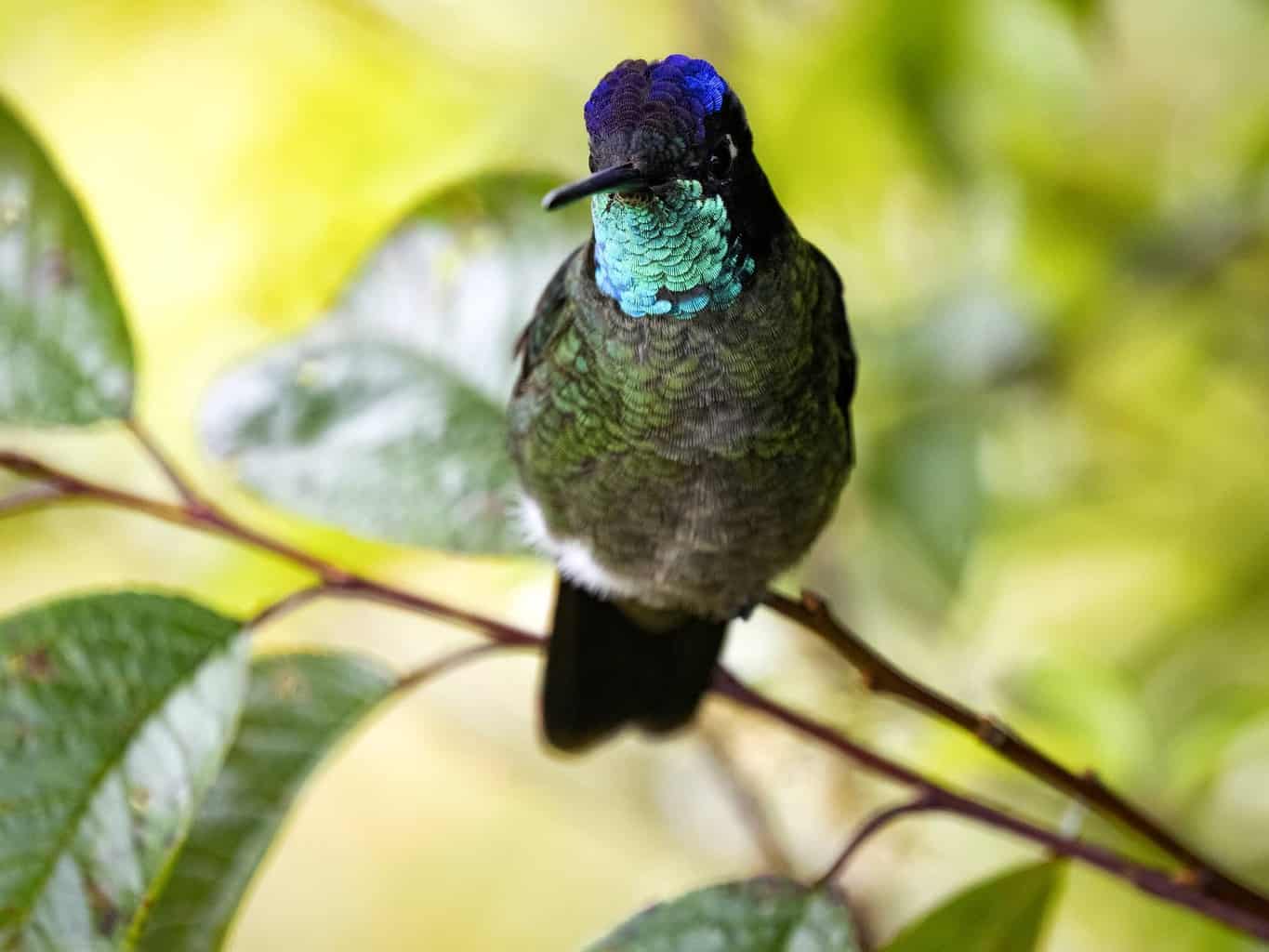
- Length: 4.3 to 5.5 inches
- Weight: 7 to 8 grams
- Wingspan: 7.1 inches
Description:
You can identify the Magnificent or Rivoli’s Hummingbirds by their large bodies, and their long, straight beak. Both sexes have a dark appearance until the sun catches a flash of iridescence plumage with purple crowns and metallic-green bodies.
Additional Information:
Rivoli’s Hummingbirds live in shady canyons and mountain ranges with pine-oak forests in the southwestern United States to Honduras. Although a rare occurrence, Rivoli’s Hummingbirds were previously spotted flying around in Arkansas from time to time.
Rivoli’s Hummingbird males are territorial and defensive birds that use aerial flight and intimidating displays to chase away other males or giant insects.
Rivoli’s Hummingbirds are generally docile and friendly birds that travel along their range between flower patches searching for a source of nectar. Additionally, they do not enjoy feeders as much as other species of hummingbirds, but they will stay close to gardens with plants that fit their feeding habits.
Fun fact: Rivoli’s Hummingbirds are known to have one of the highest recorded heartbeats ranging from 420 to 1,200 beats per minute!
Anna’s Hummingbird (Calypte Anna)
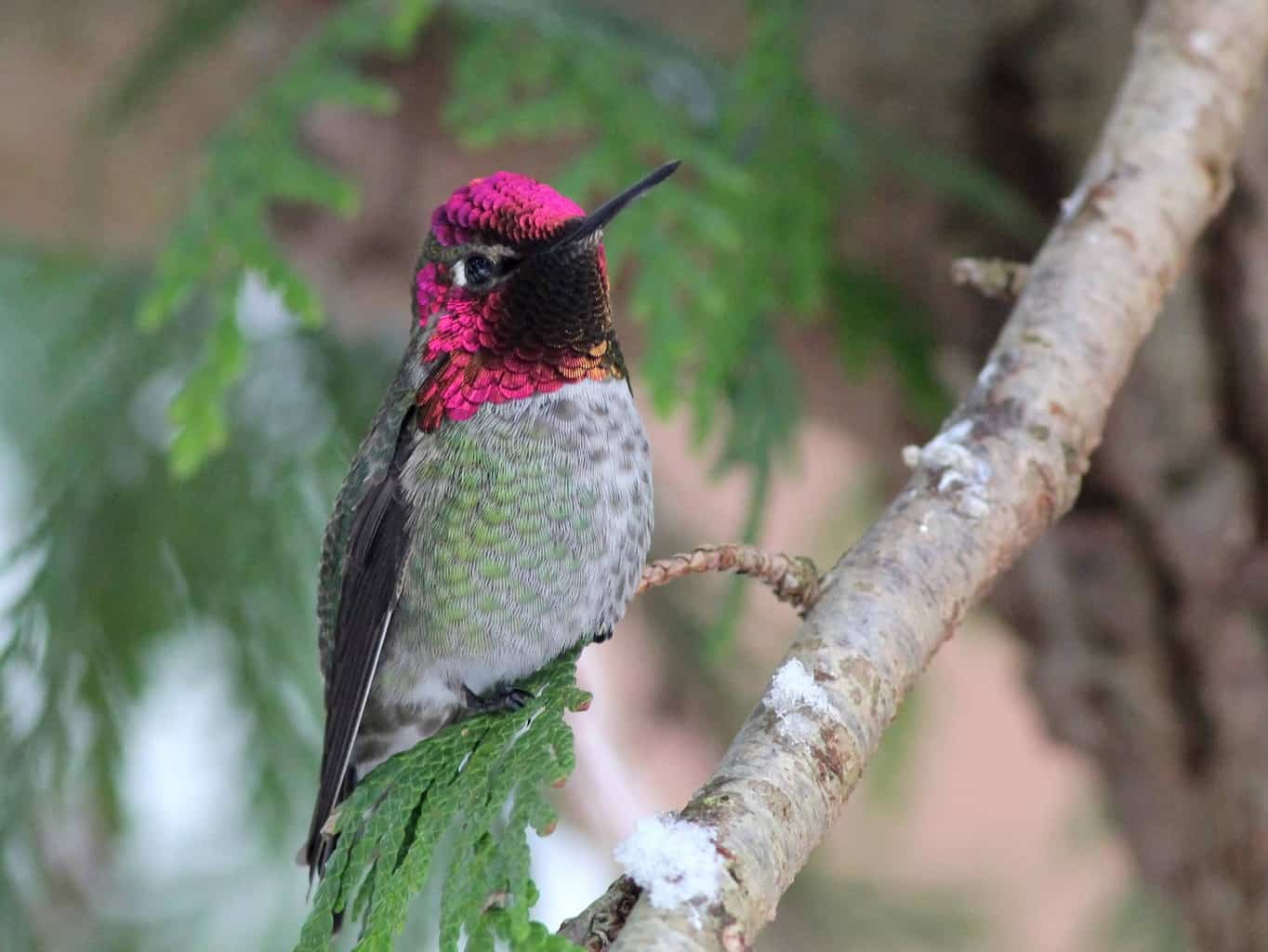
- Length: 3.9 to 4.3 inches
- Weight: 2.8 to 5.7 grams
- Wingspan: 4.7 inches
Description:
Male Anna’s have glossy, iridescent emerald-green feathers and sparkling pinkish-red crown, throat, and necks that occasionally occur black or slightly orange due to various lighting.
Additionally, female Anna’s have a pale chest with white or red spotting on the gorget, a green crown, back, and a white-tipped tail. Male Juvenile Anna’s have a similar appearance to females and gradually grow into their adult ruby hoods.
Additional Information:
Anna’s hummingbirds are of the most common and most vocal hummingbirds in the United States. But, although prominent, Anna’s hummingbird’s appearance is anything but ordinary!
Male Anna’s hummingbirds frequently display territorial behavior, making elaborate dive displays to chase away other birds or giant insects.
Anna’s hummingbird is one of few hummingbird species that produce songs with a series of sharp metallic “chip” vocalizations.
Did you know that Anna’s hummingbirds can shake their little bodies up to 55 times per second to shed rain while they are in flight?
Black-Chinned Hummingbird (Archilochus Alexandri)
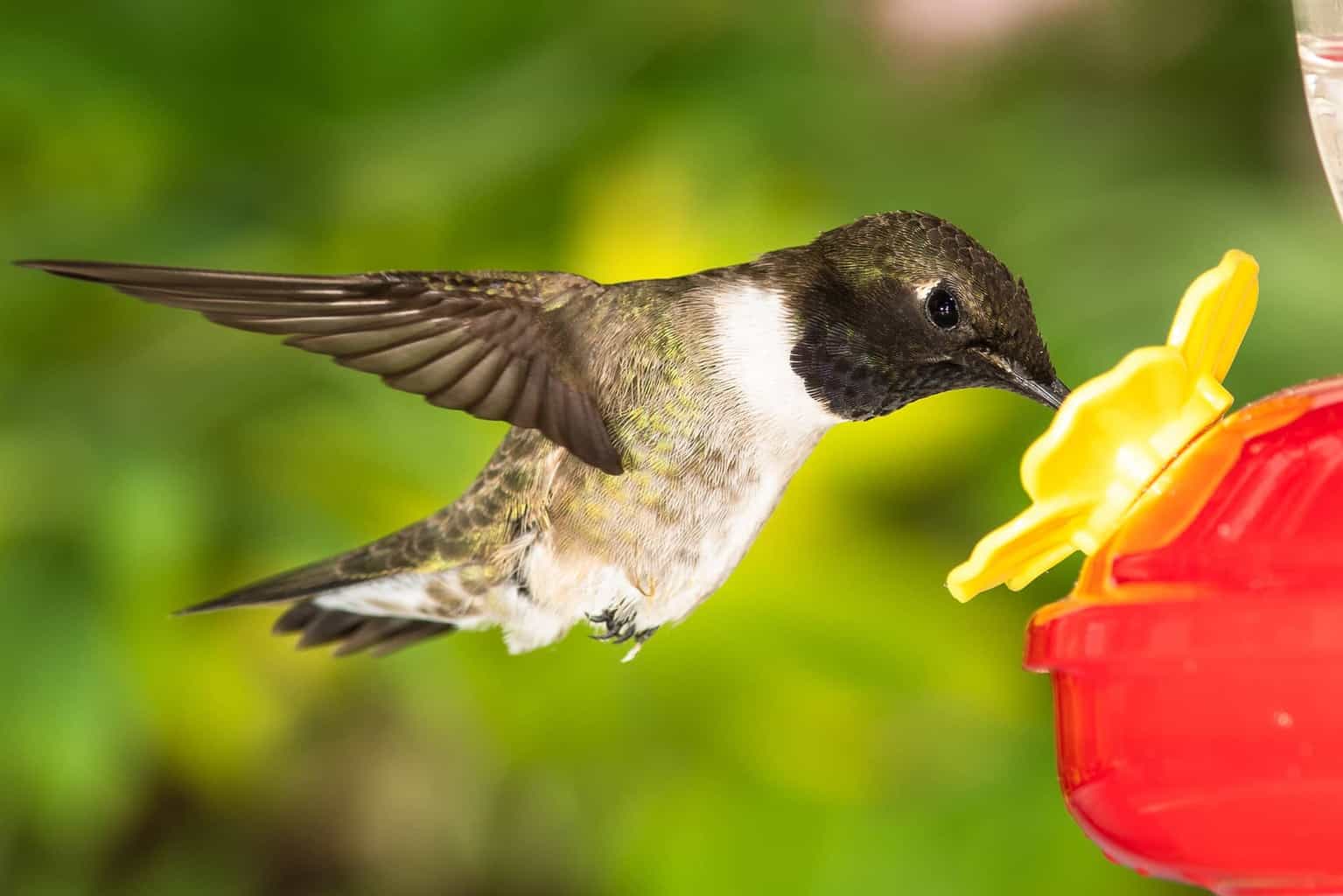
- Length: 3.25 inches
- Weight: 2.8 to 3.4 grams
- Wingspan: 4 to 5 inches
Description:
Male Black-chinned hummingbirds don’t have many brilliant colors, except for their greenish-grey heads, backs, and flanks, with a white spot right behind their eye. In addition, black-chinned hummingbirds have a distinctive black chin and iridescent purple band with a contrasting white collar around the bottom of their throat to decorate the black chin and throat.
The female chinned hummingbird has similar markings; however, females typically have faint green streaks on their white gorgets.
Additional Information:
Black-chinned hummingbirds often roam between mountain foothills, canyons, gardens, or parks.
Black-chinned hummers produce call notes or raspy chatters, especially when territorial and aggressive toward other birds or giant insects.
Fun fact: A Black-chinned Hummingbird’s eggs are approximately the size of a single coffee bean!
Rufous Hummingbird (Selasphorus Rufus)
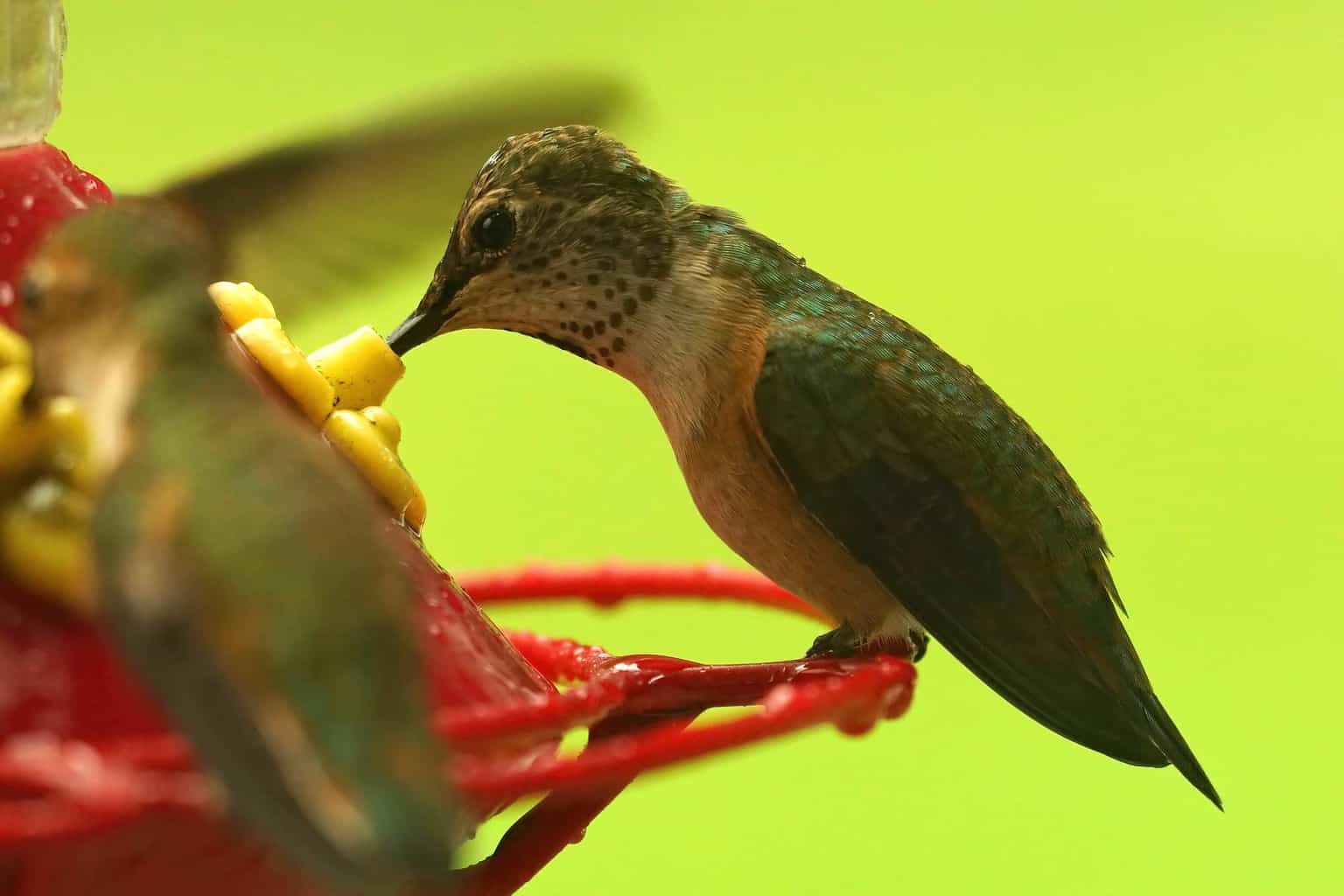
- Length: 3.5 inches
- Weight: 2 to 5 grams
- Wingspan: 4.3 inches
Description:
The male Rufous hummingbirds have a white breast with a rufous head, flanks, and tail (hence its name) with iridescent orange-red gorgets or throat patches. In addition, some males may have a greenish wash on their crown and back.
Female Rufous hummingbirds tend to be slightly larger with green heads and backs and white, speckled gorgets with central orange splotches. Lastly, female Rufous hummingbirds have a dark tail with white tips and a rufous base.
Additional Information:
Rufous hummingbirds are one of the feistiest hummingbirds in North America. Both males and females are relentless attackers that go after hummingbirds up to double their weight.
Rufous hummingbirds are wide-ranging birds that breed farther north (Alaska) than all other hummingbirds. Moreover, they have the longest migration routes of all hummingbirds in the United States. They travel over 2,000 miles from Alaska to Mexico and back.
Rufous hummingbirds can beat their wings between 52 and 62 wingbeats per second, making them hover in one place.
These little fellas enjoy feeding on sweet nectar from tubular flowers using their extendable tongues to reach the nectar. So, entice these whimsical hummingbirds by planting nectar-rich plants in your garden.
Broad-Billed Hummingbird (Cynanthus Latirostris)

- Length: 3.1 to 3.9 inches
- Weight: 3 to 4 grams
- Wingspan: 5.1 inches
Description:
The Broad-billed hummingbird has a long, vivid red beak with a black tip.
The males have a metallic dark green body with a sparkling sapphire throat and white under tail coverts. On the contrary, the females are typically less colorful, showcasing a pale belly and white eye stripes.
Additional Information:
Both male and female Broad-billed hummers are prone to be chatty, producing chatter sounds that sound like a swift “chi-dit.”
Broad-billed hummers mostly range in Mexico but can reach mountainous canyons of the southwestern United States while breeding or during migration.
The Broad-billed Hummingbird is a frequent garden visitor that primarily feeds on nectar from a wide variety of brightly colored, sweetly scented flowers.
They generally favor flowers with high nectar and sugar content and aggressively protect the nectar-rich areas with aerial flights and intimidating displays.
Broad-Tailed Hummingbird (Selasphorus Platycercus)
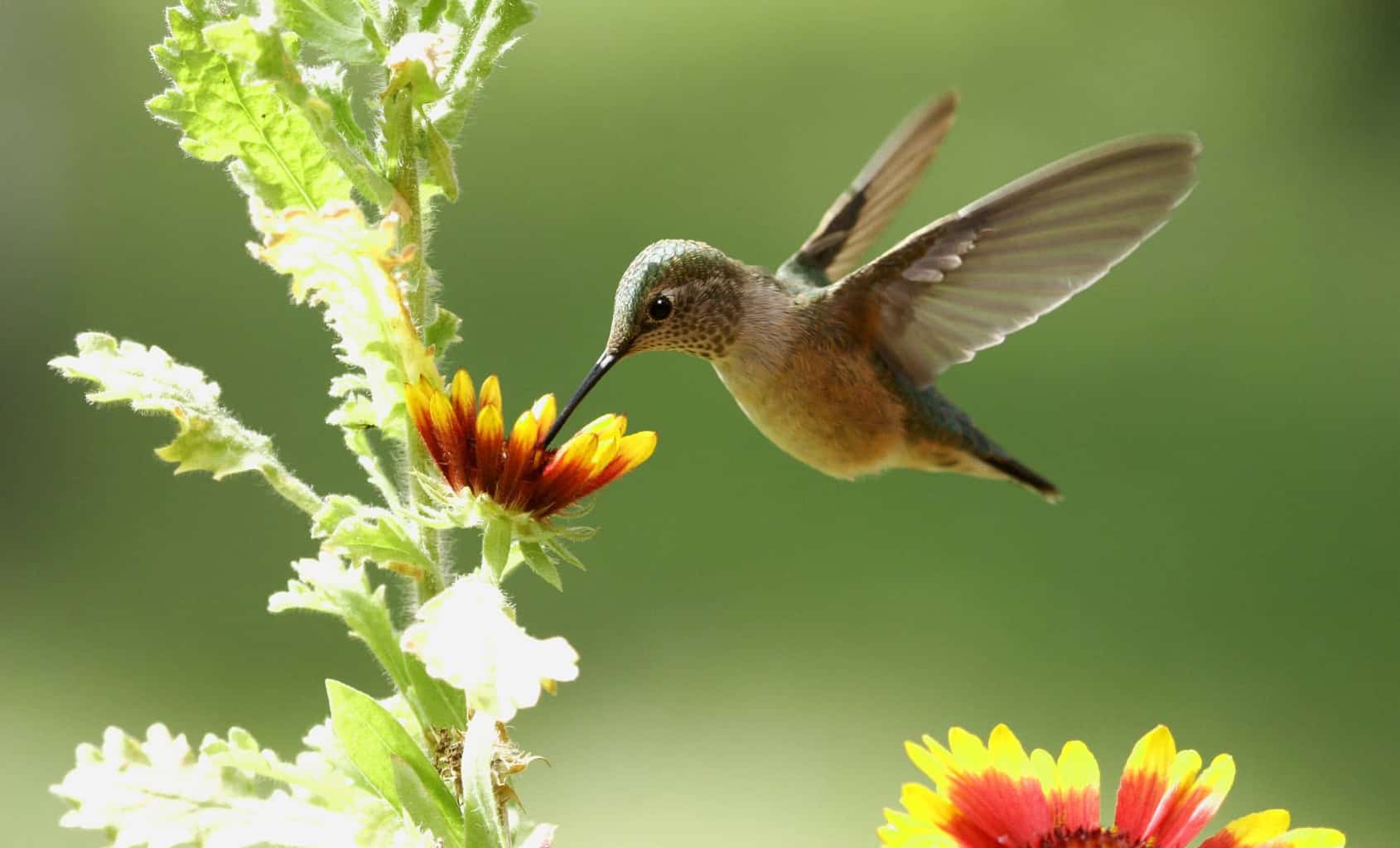
- Length: 4 inches
- Weight: 3.6 grams
- Wingspan: 5.25 inches
Description:
Broad-tailed hummingbird males are easily identified by their iridescent, magenta gorgets with white chest feathers and metallic green-gray backs and flanks.
Female Broad-tailed hummingbirds lack the flashy color and rose-red gorget and instead display a pale white throat, cinnamon flanks, and spotted cheeks.
Both male and female Broad-tailed hummers have a white eye-ring and a black, rounded tail.
Additional Information:
Broad-tailed hummingbirds are jewels of high meadow mountains that migrate between the inland areas west of the United States and Mexico. You can occasionally spot these birds flying around in Arkansas.
Broad-tailed hummingbirds enjoy feeding on nectar from brightly colored flowers of shrubs, trees, herbs, and epiphytes. Additionally, they favor red, tubular blooms with high sugar contents.
Therefore, consider planting vibrant tubular flowers in your garden or placing a hummingbird feeder to attract this beautiful hummingbird species.
The longest-lived Broad-tailed hummingbird lived over 12 years old.
Calliope Hummingbird (Stellula calliope)
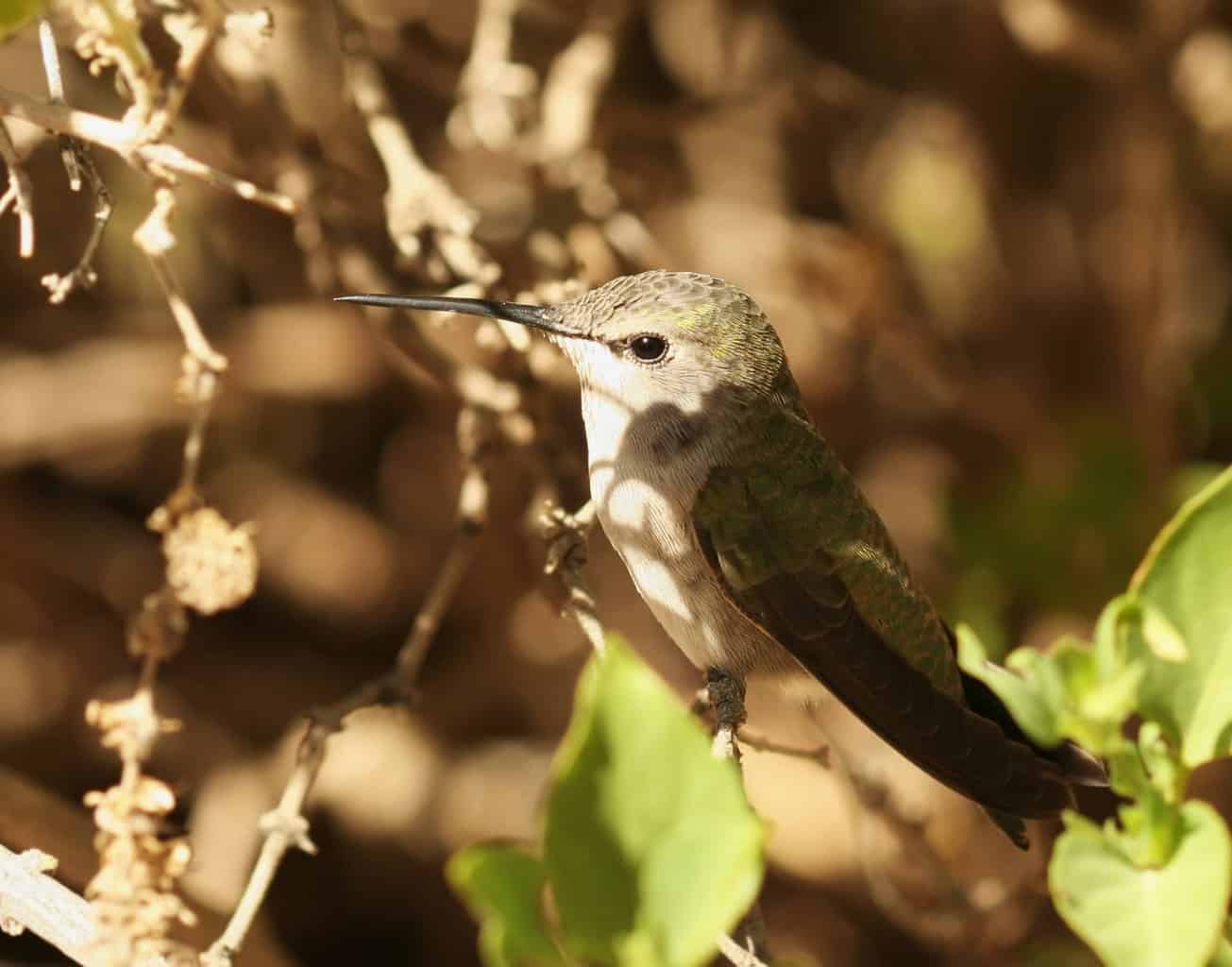
- Length: 2.8 to 3.9 inches
- Weight: 2 to 3 grams
- Wingspan: 4.3 inches
Description:
Adult Calliope males display a glossy green upper plumage and a white throat with elongated iridescent wine-red throat feathers that show a “whiskered” effect when erected. He also has green flanks and a dark tail.
Adult females display dull whitish throats with dark streaks, a pinkish was on their flanks and a dark tail with white tips. Additionally, their chests are a cinnamon-buff color.
Additional Information:
Calliope hummingbirds are the smallest breeding birds in the United States and Canada.
Calliope hummingbirds are migratory hummingbirds that typically move to their breeding ground earlier than most other species. The male Calliope hummingbirds vigorously defend their nesting territory while breeding, but males generally are well off to Mexico before the young hatch.
Calliope hummingbirds are the smallest-bodied long-distance migrants worldwide, weighing under one ounce (about the same weight as a ping pong ball).
The Calliope Hummingbird gets its common name from Calliope, the muse of eloquence and poetry, inspiring Homer’s Iliad and Odyssey.
Conclusion
There you have it, the nine hummingbirds found in Arkansas. Although many of these hummingbirds are a rare sight, the Ruby-throated hummingbird is prone to nest in Arkansas, making this beautiful gem a common site.
Arkansas is rich with vibrantly colored birds. So, if you’re an avid birder, jump over to our next exciting read on 26 must-see birds in Arkansas.

